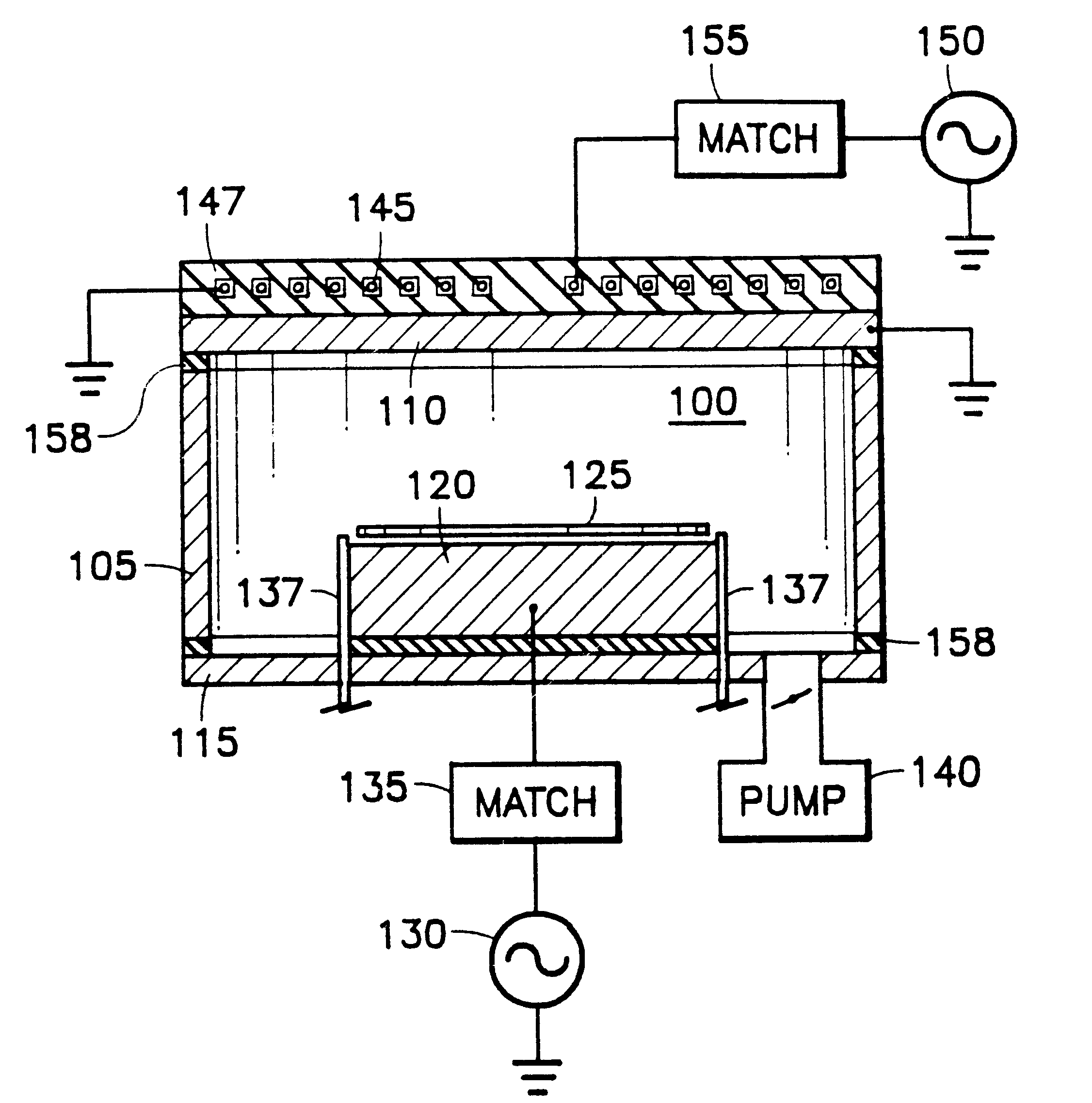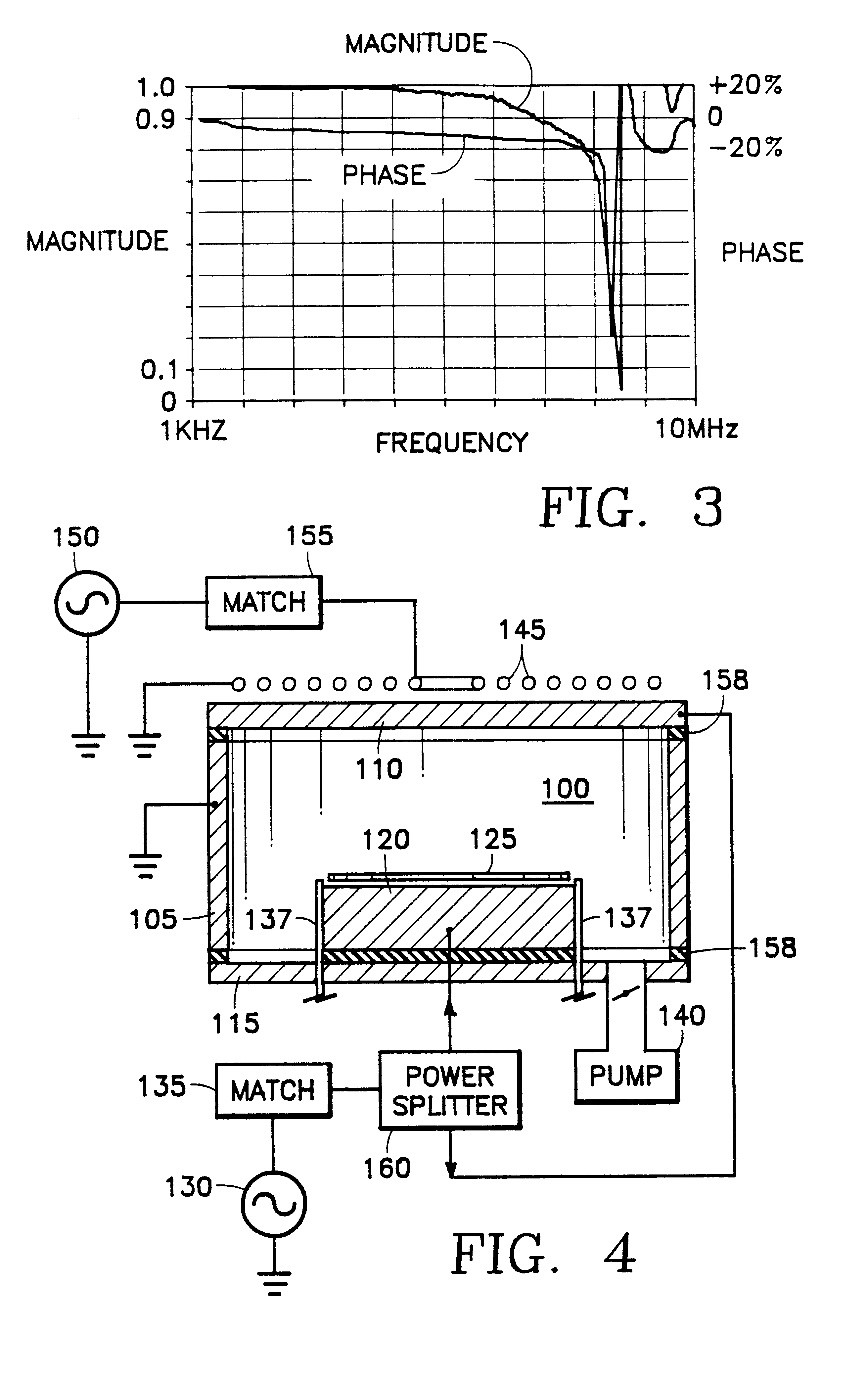In contrast, capacitively coupled reactors typically provide relatively lower plasma ion densities (e.g., on the order of only 10.sup.10 ions / cm.sup.3) and generally cannot provide independent control of
ion density and
ion energy.
However, the side wall is a poor
ground plane, as it has many discontinuities, such as a slit valve for wafer ingress and egress, gas distribution ports or apparatus and so forth.
The main problem with this type of
plasma reactor is that it is liable to exhibit processing non-uniformity across the wafer surface.
The etch process near the wafer center is dependent upon such energetic electrons traveling from the vicinity of the chamber side wall and reaching the wafer center before recombining along the way by collisions with neutral species or ions, so that the etch process is not uniform across the wafer surface.
Moreover, introduction of the etchant precursor gas from the side and
coupling of plasma source power from the side produces a non-uniform etchant ion / radical distribution favoring the side.
Many of the ions and radicals formed near side (over the wafer periphery) are consumed by
etching the
quartz side wall and are not available to etch the wafer center, while etchant ion / radical-forming energetic electrons generated near the side are lost to collisions with other species before reaching the wafer center, thus reducing the etchant ion concentration at the wafer center.
(It should be noted that the
etching of the
quartz side wall greatly increases the cost of operating the reactor because it consumes a very expensive item--the quartz side wall, which must be periodically replaced.)
The converse of the foregoing is that the relative plentitude of etchant ions and radicals near the wafer periphery can, under selected processing conditions, so impede
polymerization as to impair etch selectivity, possibly leading to punchthrough of the underlying layer near the wafer periphery, in addition to causing a much higher etch rate at the wafer periphery.
A related problem is that the hotter electrons near the chamber side wall / wafer periphery providing more energetic plasma ions in that vicinity, coupled with the
oxygen released by the etching of the quartz side wall mentioned above, erodes the edges of the
photoresist mask near the wafer periphery.
Conversely, to avoid etch-stopping at the wafer center, the concentration of etchant ions in the plasma may be increased, which risks punchthrough or
faceting near the wafer periphery.
Reducing the free
fluorine concentration in this manner has the effect of not only decreasing etch rate but also enriching the carbon content of the
polymer, thus increasing the effect of the
polymer on the etch process to guard against punch through at the wafer periphery, but increasing the risk of etch stopping at the wafer center.
Conversely, increasing the free
fluorine concentration not only increases the etch rate but also depletes the carbon content of the
polymer, thus decreasing the effect of
polymerization on the etch process, thus decreasing the risk of etch stopping at the wafer center but weakening the protection against punch through at the wafer periphery.
The problem with option (1) is that the polymer accumulated on the surface must be removed periodically, either by manual (wet) cleaning, by plasma (dry) cleaning, or by replacing the contaminated parts.
Otherwise, flaking of the polymer will occur, leading to
contamination of the chamber.
Cleaning the reactor chamber requires the reactor operation be interrupted during the entire cleaning process, which represents a significant loss of productivity and increases the cost of operating the reactor.
Problems associated with the
plasma cleaning process include not only loss of productivity but also loss of consumable materials in the chamber and
contamination.
The problem with option (2) is that etching of chamber surfaces occurs because the surfaces are exposed.
For quartz surfaces, the etching can occur at such a
high rate that the quartz parts must be replaced periodically at a significant cost in parts and lost production time.
There are, however, a number of potential problems which, if not resolved, could render the reactor of. FIG. 1 impractical.
First, there is the problem of whether the
silicon ceiling 110 will block the RF
induction field of the overhead coil antenna 145 from ever reaching the chamber 100.
Also, the RF
induction field skin depth through the plasma in the chamber 100 may be greater than the chamber height (i.e., the wafer-top
electrode gap), so that the RF induction power may not be efficiently coupled to the plasma.
Another problem is that the close proximity of the ceiling lo to the wafer 125 may be insufficient to separate the plasma sheath near the ceiling 110 from the plasma sheath near the underlying wafer 125, thereby shorting out the plasma from top to bottom.
Also,
insertion of the
silicon material of the ceiling 110 into the RF return path of the bias RF power generator 130 may occasion significant RF bias power losses.
Finally, there may not exist a suitable or practical range of resistivity values for the semiconductor window within which an RF inductive field can be coupled without undue loss or attenuation.
 Login to View More
Login to View More 


